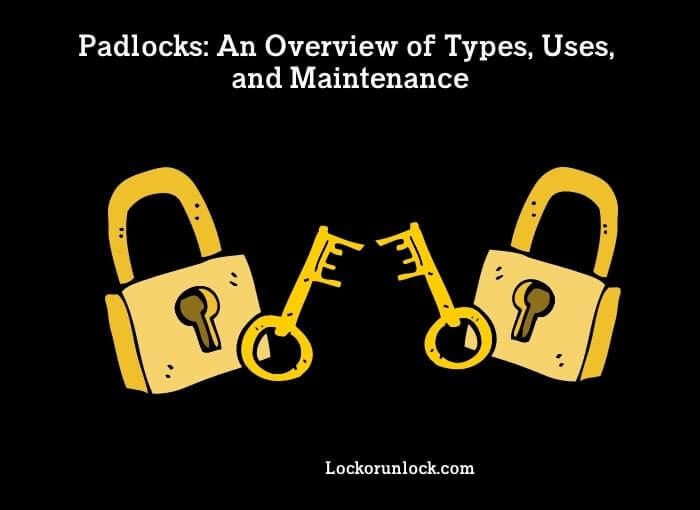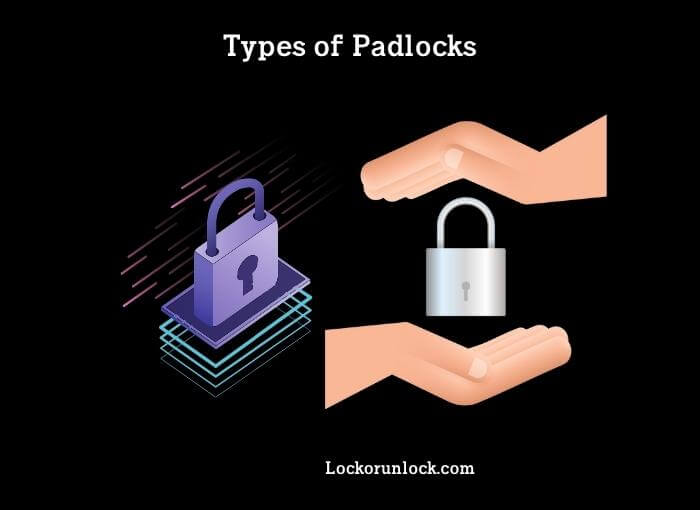In our security-conscious world, padlocks serve a crucial role. This concise guide will elucidate the various types of padlocks, their myriad uses, as well as their upkeep.
Let’s begin with the range of padlocks available in the market. Each type of padlock has a unique design and specific function, evident from the photos. Some are named for their distinctive features, such as combination padlocks, key-based padlocks, discus locks, and shutter locks. The dimensions of padlocks differ, reflecting the varied needs for security. While small ones are apt for luggage or lockers, larger ones are ideal for gates or industrial settings.

Knowing how to pick different types of padlocks is not merely a trick for locksmiths. It helps users appreciate the lock’s security level. This skill can be a lifesaver during situations like lost keys.
The material used in padlocks is an essential determinant of their durability and security. Most padlocks are constructed from hardened steel, brass, or aluminum, each with its strengths and trade-offs concerning resistance to force or corrosion.
Usage of padlocks is diverse, spanning from domestic to commercial applications. You will find them securing bicycles, lockers, gates, doors, and even used in computer systems as a security measure. The padlock icon in a web browser, for instance, signifies a secure, encrypted connection.
Maintenance is a factor often overlooked by many. A padlock parts diagram would show the complexity hidden inside these tiny devices. Regular lubrication of the lock mechanism is necessary to ensure its smooth operation and extend its lifespan.
In a nutshell, padlocks are simple, yet fascinating devices integral to our security needs. Knowing their types, uses, and maintenance can help one make informed choices and handle these devices effectively.
Padlocks
A padlock is a type of lock that is designed to be portable and easily attached to a variety of objects to provide security. It typically consists of a shackle (a U-shaped loop) and a body that contains the locking mechanism. The shackle is inserted through the object to be secured and then locked into the body of the padlock.
Padlocks can be made from a variety of materials, including brass, steel, and aluminum, and they come in a range of sizes and strengths for different levels of security. They are commonly used to secure gates, fences, storage units, and other items that need to be locked up.
Types of Padlocks
Padlocks come in several types, each with unique features and advantages. Here are some of the most common types of padlocks:
Combination Padlocks
Combination padlocks are popular for their convenience and ease of use. They operate using a numerical code that the user sets, and the lock can only be opened by entering the correct combination. Combination padlocks are available in different sizes and security levels, making them suitable for a wide range of applications.
Keyed Padlocks
Keyed padlocks are more traditional and offer a higher level of security than combination padlocks. They use a physical key to unlock them, making them harder to bypass. Keyed padlocks are available in different keying options such as keyed alike or keyed differently, making them suitable for various applications.

Smart Padlocks
Smart padlocks are a newer type of padlock that uses modern technology such as Bluetooth and Wi-Fi to communicate with a smartphone or computer. Smart padlocks offer features such as remote access, monitoring, and alerts, making them convenient for home and business security applications.
Disc Padlocks
Disc padlocks are a type of keyed padlock that uses a circular shackle, making it harder to cut or pry. Disc padlocks are suitable for applications that require high-security levels, such as storage units and gates.
Shrouded Padlocks
Shrouded padlocks offer additional protection against bolt cutters and saws by enclosing the shackle with a hardened steel case. Shrouded padlocks are suitable for applications that require high-security levels, such as storage units and gates.
Weatherproof Padlocks
Weatherproof padlocks are designed to withstand harsh weather conditions, making them suitable for outdoor applications. They are typically made of materials such as stainless steel and have features such as rust-resistant coatings and weatherproof seals.
Choosing the right type of padlock depends on the application, security needs, and personal preferences. Consider factors such as strength, security level, weather resistance, size and weight, and price when choosing a padlock.
Factors to Consider When Choosing a Padlock
Choosing the right padlock is essential to ensure that your valuable items are kept safe and secure. Here are some factors to consider when choosing a padlock:
Strength
The strength of a padlock is determined by its shackle and body materials. Look for padlocks made of materials such as hardened steel, brass, or boron alloy, as they offer high levels of strength and durability.
Security Level
Padlocks come with different security levels, which are determined by testing agencies such as the American National Standards Institute (ANSI) and the European Committee for Standardization (CEN). Look for padlocks that have been rated according to these standards, with higher ratings indicating higher security levels.
Weather Resistance
If you plan to use the padlock outdoors, consider weather-resistant options. Look for padlocks made of materials such as stainless steel, with weather-resistant coatings and seals.
Size and Weight
The size and weight of the padlock will depend on the application. For example, a larger padlock may be suitable for securing gates or storage units, while a smaller padlock may be better for securing luggage or backpacks.
Price
Padlocks vary in price, and the cost will depend on the features, materials, and security levels. Consider your budget when choosing a padlock, but keep in mind that the cheapest option may not always be the best choice.
Brand and Reputation
Look for padlocks from reputable brands with a proven track record of quality and reliability. Reading reviews and ratings from other customers can also help you make an informed decision.
Common Uses for Padlocks
Padlocks are versatile and can be used in a wide range of applications. Here are some common uses for padlocks:
Lockers and Cabinets
Padlocks are commonly used to secure lockers and cabinets in gyms, schools, and offices. Combination padlocks are often preferred for this application, as they allow multiple users to access the same lock without the need for keys.
Gates and Fences
Padlocks are often used to secure gates and fences around homes, businesses, and public areas. Disc padlocks or shrouded padlocks are preferred for this application, as they offer a higher level of security against bolt cutters and saws.
Bicycles and Motorcycles
Padlocks are commonly used to secure bicycles and motorcycles when parked. U-locks and chain locks are preferred for this application, as they offer a high level of strength and security against theft.
Luggage and Travel
Padlocks are commonly used to secure luggage when traveling. Combination padlocks or keyed padlocks are preferred for this application, as they offer a level of security against theft and tampering.
Storage Units
Padlocks are commonly used to secure storage units and lockers in self-storage facilities. Disc padlocks or shrouded padlocks are preferred for this application, as they offer a high level of security against bolt cutters and saws.
Safes and Vaults
Padlocks are commonly used to secure safes and vaults in homes and businesses. High-security padlocks such as those with hardened boron alloy or titanium shackles are preferred for this application, as they offer a high level of strength and security.
Proper Use and Maintenance of Padlocks
Proper use and maintenance of padlocks are essential to ensure their longevity and effectiveness. Here are some tips for using and maintaining your padlock:
Proper Installation: Make sure that your padlock is installed properly according to the manufacturer’s instructions. Improper installation can weaken the lock’s effectiveness and make it easier for thieves to break into.
Proper Use: Always use your padlock properly and for its intended application. Using the wrong type of lock or using it improperly can make it easier for thieves to break into.
Lubrication: Regularly lubricate your padlock to ensure that the locking mechanism functions smoothly. Use a high-quality lubricant, such as graphite or silicone spray, and apply it sparingly to avoid attracting dirt and dust.
Inspection: Inspect your padlock regularly to ensure that it is in good condition. Check for signs of damage, rust, or wear and tear, and replace the lock if necessary.
Cleaning: Clean your padlock regularly to remove dirt, dust, and debris. Use a soft, damp cloth and mild detergent to clean the lock, and avoid using abrasive materials that can damage the lock’s finish.
Storage: When not in use, store your padlock in a dry, clean place to prevent rust and corrosion. Avoid storing it in direct sunlight or humid areas.
Benefits of Padlocks
Padlocks offer several benefits as a security device. Here are some of the key benefits of using padlocks:
Portability
Padlocks are small and easy to carry, which makes them highly portable. This makes them ideal for securing items that need to be moved frequently, such as bicycles, lockers, and storage containers.
Versatility
Padlocks can be used in a variety of settings and on a wide range of objects. They can be attached to gates, doors, cabinets, and other items that need to be secured.
Durability
High-quality padlocks are built to last and can withstand harsh weather conditions and attempts to break them. They are typically made from materials such as steel, brass, and aluminum, which are strong and corrosion-resistant.
Customization
Padlocks can be customized with different keying options, such as keyed alike or keyed different, to suit the specific needs of the user. This allows for greater flexibility and convenience when it comes to managing security.
Cost-Effective
Padlocks are generally affordable and offer good value for money. They provide a basic level of security that is sufficient for many applications, making them a cost-effective solution for securing items.
How Can I Use Different Types of Padlocks to Secure Public Storage?
When it comes to securing public storage, understanding how to handle being locked with different types of padlocks is essential. Combination padlocks offer convenience, while key-operated padlocks provide traditional security. For added protection, consider using a heavy-duty padlock with a shrouded shackle for maximum security.
Is a Can-Am Defender with Halo Locker a Secure Option for Protecting my Off-Road Vehicle?
Yes, a Can-Am Defender with Halo Locker is a highly secure option for protecting your offroad vehicle with halo locker. The Halo Locker system provides advanced security features, ensuring that your vehicle is protected from theft or unauthorized access. This added security feature gives you peace of mind when leaving your offroad vehicle unattended.
Conclusion
Padlocks are an essential tool for securing your valuable items and keeping them safe from theft or tampering. With the right type of padlock and proper use and maintenance, you can ensure that your belongings are secure and protected.
When choosing a padlock, consider the level of security required for the specific application and the factors such as the weather conditions, the type of material to be locked, and the level of durability needed. By keeping these factors in mind, you can choose a padlock that meets your needs and offers the required level of security.
It is essential to use and maintain the padlock properly to ensure its longevity and effectiveness. Regular lubrication, inspection, cleaning, and storage can help extend the life of your padlock and ensure that it functions smoothly and effectively.
Read more:
